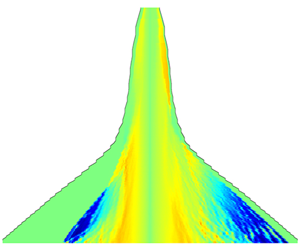Crossref Citations
This article has been cited by the following publications. This list is generated based on data provided by
Crossref.
Yan, Zheng
Li, Xinliang
Yu, Changping
and
Wang, Jianchun
2020.
Cross-chirality transfer of kinetic energy and helicity in compressible helical turbulence.
Physical Review Fluids,
Vol. 5,
Issue. 8,
Yan, Zheng
Li, Xinliang
and
Yu, Changping
2020.
Scale locality of helicity cascade in physical space.
Physics of Fluids,
Vol. 32,
Issue. 6,
Yao, Jie
and
Hussain, Fazle
2021.
Polarized vortex reconnection.
Journal of Fluid Mechanics,
Vol. 922,
Issue. ,
Milanese, Lucio M.
Loureiro, Nuno F.
and
Boldyrev, Stanislav
2021.
Dynamic Phase Alignment in Navier-Stokes Turbulence.
Physical Review Letters,
Vol. 127,
Issue. 27,
Yu, Changping
Hu, Running
Yan, Zheng
and
Li, Xinliang
2022.
Helicity distributions and transfer in turbulent channel flows with streamwise rotation.
Journal of Fluid Mechanics,
Vol. 940,
Issue. ,
Ali, Sk Zeeshan
and
Dey, Subhasish
2022.
Discovery of the zeroth law of helicity spectrum in the pre-inertial range of wall turbulence.
Physics of Fluids,
Vol. 34,
Issue. 7,
Yan, Zheng
Fu, Yaowei
Wang, Lifeng
Yu, Changping
and
Li, Xinliang
2022.
Effect of chemical reaction on mixing transition and turbulent statistics of cylindrical Richtmyer–Meshkov instability.
Journal of Fluid Mechanics,
Vol. 941,
Issue. ,
Baj, P.
Alves Portela, F.
and
Carter, D.W.
2022.
On the simultaneous cascades of energy, helicity, and enstrophy in incompressible homogeneous turbulence.
Journal of Fluid Mechanics,
Vol. 952,
Issue. ,
Pouquet, Annick
and
Yokoi, Nobumitsu
2022.
Helical fluid and (Hall)-MHD turbulence: a brief review.
Philosophical Transactions of the Royal Society A: Mathematical, Physical and Engineering Sciences,
Vol. 380,
Issue. 2219,
Zhang, Yi
Palha, Artur
Gerritsma, Marc
and
Rebholz, Leo G.
2022.
A mass-, kinetic energy- and helicity-conserving mimetic dual-field discretization for three-dimensional incompressible Navier-Stokes equations, part I: Periodic domains.
Journal of Computational Physics,
Vol. 451,
Issue. ,
p.
110868.
Yan, Zheng
Li, Xinliang
and
Yu, Changping
2022.
Helicity budget in turbulent channel flows with streamwise rotation.
Physics of Fluids,
Vol. 34,
Issue. 6,
Hu, Running
Li, Xinliang
and
Yu, Changping
2022.
Transfers of energy and helicity in helical rotating turbulence.
Journal of Fluid Mechanics,
Vol. 946,
Issue. ,
Su, Yunde
and
Yang, Yue
2023.
Interaction between trefoil knotted flame and vortex.
Physical Review Fluids,
Vol. 8,
Issue. 12,
Fritts, David C.
Lund, Thomas S.
Lund, Adam C.
and
Wang, Ling
2023.
Turbulence Transitions in Kelvin–Helmholtz Instability “Tube” and “Knot” Dynamics: Vorticity, Helicity, and Twist Waves.
Atmosphere,
Vol. 14,
Issue. 12,
p.
1770.
2023.
Numerical study of the precession-driven flow inside a sphere using helical wave decomposition.
Physics of Fluids,
Vol. 35,
Issue. 4,
Meng, Zhaoyuan
Shen, Weiyu
and
Yang, Yue
2023.
Evolution of dissipative fluid flows with imposed helicity conservation.
Journal of Fluid Mechanics,
Vol. 954,
Issue. ,
Capocci, Damiano
Johnson, Perry L.
Oughton, Sean
Biferale, Luca
and
Linkmann, Moritz
2023.
New exact Betchov-like relation for the helicity flux in homogeneous turbulence.
Journal of Fluid Mechanics,
Vol. 963,
Issue. ,
Pham, Oanh L.
and
Papavassiliou, Dimitrios V.
2023.
Helicity and dissipation correlation in anisotropic turbulent flow fields.
Physics of Fluids,
Vol. 35,
Issue. 10,
Yan, Zheng
Wu, Junfeng
Lei, Zhu
Wang, Jianchun
Wang, Lifeng
Li, Xinliang
and
Yu, Changping
2024.
Helicity transfer in compressible turbulent flows.
Physical Review Fluids,
Vol. 9,
Issue. 9,
Pham, Oanh L.
and
Papavassiliou, Dimitrios V.
2024.
Lagrangian investigation of the correlation of helicity with coherent flow characteristics for turbulent transport.
Physics of Fluids,
Vol. 36,
Issue. 1,
